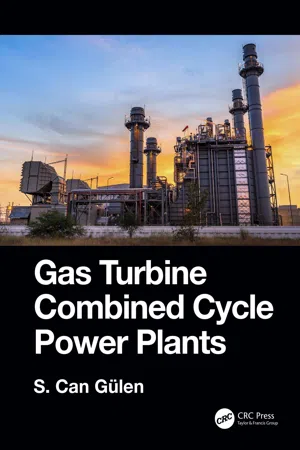
- 530 pages
- English
- ePUB (mobile friendly)
- Available on iOS & Android
Gas Turbine Combined Cycle Power Plants
About this book
This book covers the design, analysis, and optimization of the cleanest, most efficient fossil fuel-fired electric power generation technology at present and in the foreseeable future.
The book contains a wealth of first principles-based calculation methods comprising key formulae, charts, rules of thumb, and other tools developed by the author over the course of 25+ years spent in the power generation industry. It is focused exclusively on actual power plant systems and actual field and/or rating data providing a comprehensive picture of the gas turbine combined cycle technology from performance and cost perspectives.
Material presented in this book is applicable for research and development studies in academia and government/industry laboratories, as well as practical, day-to-day problems encountered in the industry (including OEMs, consulting engineers and plant operators).
Frequently asked questions
- Essential is ideal for learners and professionals who enjoy exploring a wide range of subjects. Access the Essential Library with 800,000+ trusted titles and best-sellers across business, personal growth, and the humanities. Includes unlimited reading time and Standard Read Aloud voice.
- Complete: Perfect for advanced learners and researchers needing full, unrestricted access. Unlock 1.4M+ books across hundreds of subjects, including academic and specialized titles. The Complete Plan also includes advanced features like Premium Read Aloud and Research Assistant.
Please note we cannot support devices running on iOS 13 and Android 7 or earlier. Learn more about using the app.
Information
1 Introduction
- Gas turbine generator (operating in Brayton cycle)
- Steam turbine generator (operating in Rankine cycle)
- Heat recovery boiler or, using the more common terminology, heat recovery steam generator (HRSG)
- Heat rejection system comprising either
- A water-cooled condenser (with or without a cooling tower) or
- An air-cooled condenser (ACC).
- Familiarize the reader with the “ghost in the machine”, i.e., the basic fundamental principles of thermodynamics (by far, the most important discipline of mechanical engineering – at least in this author’s opinion) governing the operation of the prime movers and heat exchange devices in the gas turbine combined cycle power plant.
- Provide tools to do high-level analysis at different stages of design (conceptual, detailed, etc.) and operation (performance test, root cause analysis, etc.) and check the results of sophisticated computer simulation tools with steep learning curves and “black box” inner details.
1.1 Note on Units
- ° C = (° F − 32)/1.8
- K = ° C + 273.15 (degrees Kelvin)
- R = ° F + 459.67 (degrees Rankine).
- 1 psi = 0...
Table of contents
- Cover
- Half Title
- Title Page
- Copyright Page
- Table of Contents
- Preface
- Author
- Chapter 1 Introduction
- Chapter 2 Prerequisites
- Chapter 3 Bare Necessities
- Chapter 4 Gas Turbine
- Chapter 5 Steam Turbine
- Chapter 6 Heat Recovery Steam Generator (HRSG)
- Chapter 7 Heat Sink Options
- Chapter 8 Combining the Pieces
- Chapter 9 Major Equipment
- Chapter 10 Balance of Plant
- Chapter 11 Construction and Commissioning
- Chapter 12 Environmental Considerations
- Chapter 13 Economics
- Chapter 14 Cogeneration
- Chapter 15 Operability
- Chapter 16 Maintenance
- Chapter 17 Repowering
- Chapter 18 Integrated Gasification Combined Cycle
- Chapter 19 Carbon Capture
- Chapter 20 What Next?
- Appendix A: Property Calculations
- Appendix B: Standard Conditions for Temperature and Pressure
- Appendix C: Exergetic Efficiency
- Appendix D: Thermal Response Basics
- Appendix E: Steam Turbine Stress Basics
- Appendix F: Carbon Capture
- Index